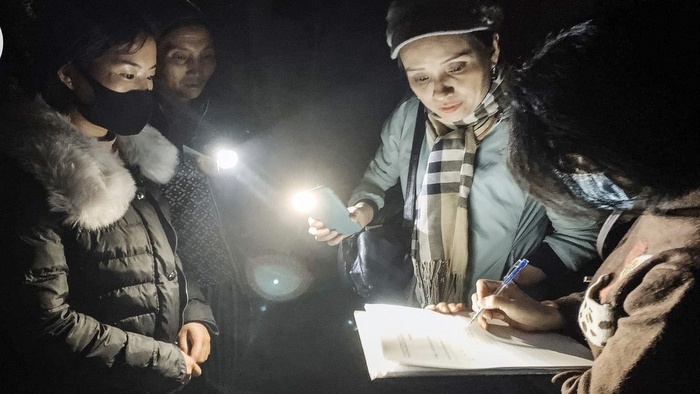During their six-day field trip to two border districts of Phong Tho and Sin Ho in Lai Chau province, the delegation of Vietnam Women’s Museum, collected 141 artifacts, including key chains, earrings, dresses, clothes and utensils of Dao, Lu, Mong, Ha Nhi and Thai Trang ethnic minority groups, that have been preserved over generations.
The delegation’s members collected traditional dress of Mong ethnic people in Dao Sa commune, Phong Tho district, which feature mixed technical elements of Lo Lo people. Talking about this dress, Bui Thi Thanh Thuy from Vietnam Women’s Museum, said Mong ethnic minority people in Dao San call themselves Mong Lo Lo. This was clearly shown through their traditional costumes with the skirts having typical features of Mong people (beeswax drawing, pleats, gored shapes and indigo dye). However, the upper part has pieces of fabric grafted together into patterns and textures with typical shapes of Lo Lo people. In scientific studies and documents from field trips, there is no Mong Lo Lo ethnic minority group and Dao San commune a residential area of the Lo Lo ethnic people.
In remote border communes, where traffic is difficult, the cultural interference has not been strong. The cultural customs have not changed so much and local ethnic minority people have preserved their own cultural identities. Especially, the older people still keep in memory many stories about the customs and rituals of ethnic groups.
For Dao people in Ta Phin village, Ta Phin commune, Sin Ho district, their traditional costumes and jewellery have been considered their assets that have been passed down through generations. These artifacts contain spiritual beliefs and cultural characteristics. Dao people think that the heritages’ values are not precious materials and metals, but the assets which feature many stories and beliefs as well as used by many generations. For example, when mother-in-laws and mothers gave dowry costumes and jewellery to their daughter-in-laws and daughters at a wedding, they asked their children to keep them safe for the next generation. Therefore, in daily life today, Dao people can wear bronze earrings and modern clothes; however, the traditional cotton costumes that are hand-sewn and hand-embroidered and silver earrings are still family heirlooms. Dao ethnic people believe that if they do not hold the heritages of the ethnic group, they will not be buried with the assets when they die, so they cannot meet their ancestors in the afterlife. This unchanging belief is a binding factor that helps preserve the heritages in the community. The elderly always orients traditional values and remind their families’ members, particularly younger generations, of conserving their heritages.
Living by farming and raising cattle, the life of Xinh Mun people in Phieng Khoai commune, Yen Chau district, Son La province has changed gradually. They have adapted to the modern life, given up unsound custom of early marriage and having inbred children, and boosting economic development while keeping many unique and long-term customs and cultural rituals. Hoang Nhu Hoa, an official from Vietnam Women’s Museum, who witnessed the pregnancy and childbirth rituals of Xinh Mun ethnic minority people, said all steps of performing the rituals were aimed at praying for the babies’ peace, helping family members feel secure and promoting the bond among members. Xinh Mun parents have always accompanied and passed down folk knowledge to their children. The records and audio tapes of narrations and stories from the owners of objects, documents and images about the life, customs and rituals of Xinh Mun ethnic minority people, have provided the working delegation’s members and viewers with the most direct and honest view of material and cultural values.
Implementing the Prime Minister’s Decision No.219/QD-TTg, approving the project to support the communications of ethnic and religious work, the Vietnam Women’s Museum has collected artifacts and stories related to traditional customs and rituals of ethnic minority groups in border districts of Son La, Lai Chau and Yen Bai. According to Director of Vietnam Women’s Museum Nguyen Hai Van, the museum will create legal documents and procedures and attach identification codes for the collected objectives to make them become national assets. The values of artifacts and cultural heritages will be exploited and promoted to meet the goal of wide propaganda so that the public can better understand the unique customs and cultural identities of 54 ethnic groups in Vietnam.
It can be said that the research, preservation, collection and preservation of documents and artifacts in the museums have been forming a unity in both material and cultural values. Through exhibitions, movies and digital transformation, this common block of documents and artifacts will contribute to enriching knowledge about customs, rituals and practices in the life of ethnic people in the border areas of Son La and Lai Chau provinces.




